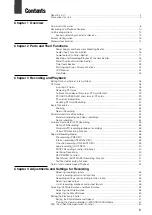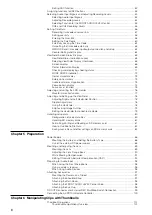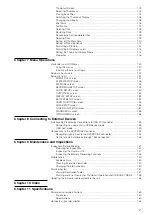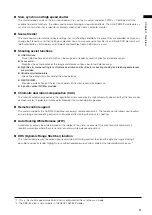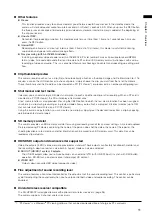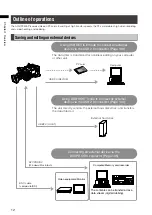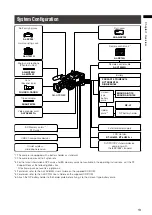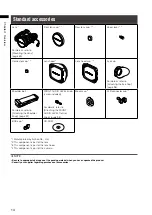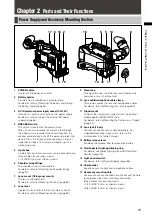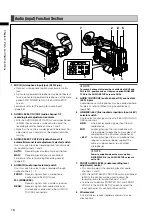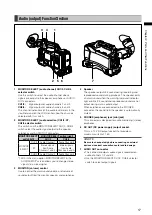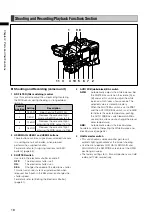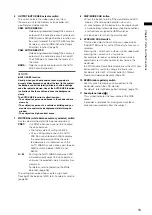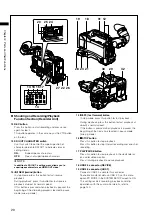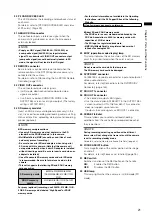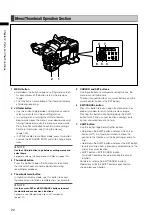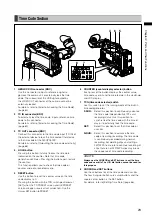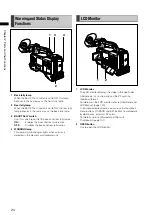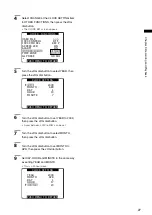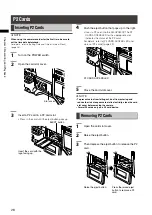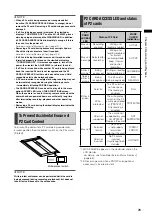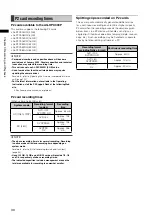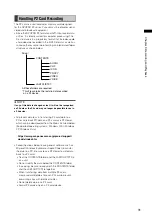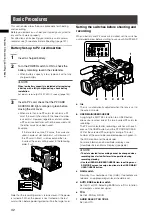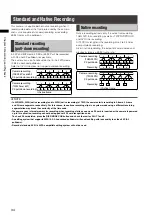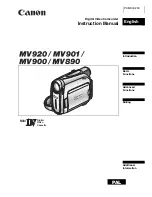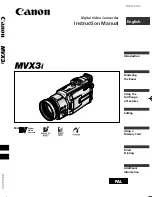
1
Chapter
P
ar
ts
and
their
Functions
6 OUTPUT/AUTO KNEE selector switch
This switch selects the video signals sent from
the camera unit to the memory card recorder unit,
viewfinder and video monitor.
CAM. AUTO KNEE ON:
Video being recorded through the camera is
output with the Auto knee circuit activated. A
DRS (Dynamic Range Stretcher) function can
be used instead of the AUTO KNEE function.
For details, refer to [DRS (Dynamic Range
Stretcher) function] (page 9).
CAM. AUTO KNEE OFF:
Video being recorded through the camera is
output with the Auto knee circuit turned off.
The KNEE point is locked to the level set in
the menu.
BARS:
Color bar signals are output with the AUTO
KNEE circuit turned off.
NOTE
AUTO KNEE function
Usually, when you shoot people or scenery against a
strongly lit background and adjust the level to the subject,
the background will be totally whited-out, with buildings
and other objects blurred. Use of the AUTO KNEE function
in situations like these will reproduce the background
clearly.
The AUTO KNEE function is effective when:
• The subject is a person positioned in the shade under a
clear sky.
• The subject is a person in a vehicle or building and you
also want to capture the background visible through a
window.
• The subject is a high-contrast scene.
7 WHITE BAL (white balance memory selector) switch
Use to select method of white balance adjustment.
PRST:
Use PRST when you have no time to adjust
the white balance.
• The factory default setting is 3200 K.
• Use a setting menu or push the AUTO
W/B BAL switch towards AWB to display
the color temperature. While the color
temperature is still indicated, push the
AUTO W/B BAL switch once again towards
AWB to switch between 3200 K and
5600 K.
A • B:
Pushing the AUTO W/B BAL towards AWB
will automatically adjust the white balance
and save the adjusted value in memory A or
memory B.
For details, refer to [Adjusting the White
Balance] (page 48).
The setting menu also allows you to assign Auto
Tracking White balance (ATW) to B. For details, refer to
(page 49).
8 DISP/MODE CHK button
• Press this button to turn off the viewfinder and LCD
display. (The time code indication stays on.)
• A second press of the button turns the display back
on and holding it down displays shooting conditions
and functions assigned to USER switches.
• It also serves to turn off the alarm sound.
9 SYNCHRO SCAN switch
This function adjusts the synchro scan speed when
the SHUTTER switch is set to ON and synchro scan is
selected.
Pressing the – switch sets a slower shutter speed and
pressing the + switch sets a faster one.
For example, to record a computer screen, make
adjustments to minimize horizontal bar noise in the
viewfinder.
In VFR (Variable Frame Rate) mode, press the JOG dial
button and this switch to change the frame rate.
For details, refer to [2. JOG dial button] in [Menu/
Thumbnail Operation Section] (Page 22).
10 ZEBRA (zebra pattern) switch
Use this switch to display a zebra pattern in the
viewfinder and on the LCD monitor.
For details, refer to [Zebra pattern display] (page 74).
11 Focal plane index ( )
This symbol indicates the focal plane of the MOS
sensor.
It provides a reference for making accurate focal
distance measurements from the subject.

